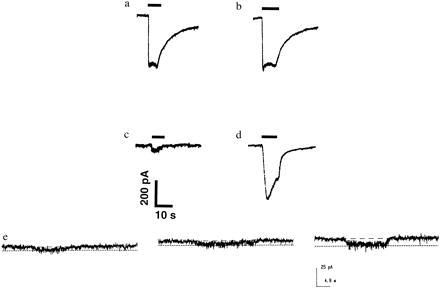Figure 2.

Whole-cell recording of homocysteine-evoked currents are increased by glycine. (a) Current evoked by 200 μM NMDA plus 1 μM glycine. (b) Current evoked by 200 μM NMDA plus 50 μM glycine. (c) The current evoked by 10 mM d,l-homocysteine (or 5 mM l-homocysteine, a maximal stimulus) with 1 μM glycine was relatively small. (d) Increasing the glycine concentration to 50 μM increased the magnitude of the current evoked by homocysteine on the same cortical neuron as in c. This action was not voltage-dependent as similar effects were seen at a holding potential of +40 mV (data not shown). Possibly due to rundown of the currents, 50 μM glycine did not always increase the maximal homocysteine-evoked current to the same level as the maximal NMDA-induced current in all neurons tested (n = 7). However, in each case the effect was qualitatively similar to that observed during the calcium imaging experiments. (e) Micromolar homocysteine evoked measurable currents in the presence of glycine and bicarbonate. When 200 μM d,l-homocysteine (equivalent to 100 μM l-homocysteine) was applied in Hanks’ balanced salt solution, a small macroscopic current was observed (left trace). To simulate physiological conditions, 24 mM bicarbonate was added, and then the same micromolar concentration of homocysteine elicited a somewhat larger whole-cell current (center trace; similar to the effect of bicarbonate on cysteine-induced currents noted previously; ref. 9). Application of 50 μM glycine in addition to the bicarbonate further increased the homocysteine-activated current to 200% (right trace). In e, the bath solution was made somewhat acidic (pH = 7.0 rather than 7.2) to more closely simulate ischemic conditions.
